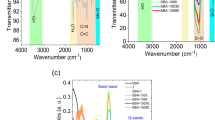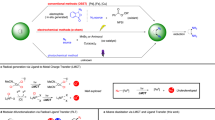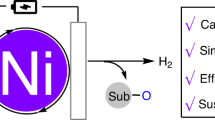Abstract
The development of a procedure for the epoxidation of alkenes with molecular oxygen is an important industrial and synthetic goal. Non-radical activation of dioxygen by monooxygenase enzymes such as the iron-porphyrin-based cytochrome P-450 involves the insertion of one oxygen atom of O2 into the organic substrate while the other oxygen is reduced to water in the presence of an electron donor. Dioxygenase enzymes, on the other hand, catalyse insertion of both oxygen atoms without reducing agents. Oxidation of hydrocarbons with dioxygen catalysed by transition-metal compounds invariably proceeds by free-radical pathways rather than by dioxygenase-type reactions, and so do not allow the epoxidation of alkenes with molecular oxygen. The sterically hindered ruthenium tetramesityl porphyrin complex has been shown previously to activate dioxygen in a dioxygenase mode1. We describe here the use of the polyoxometalate {[WZnRu2(OH)(H2O)](ZnW9O34)2}11−(ref. 2) as a catalyst for non-radical molecular oxygen activation and alkene epoxidation. The polyoxometalate can be considered to act as an inorganic dioxygenase catalyst. The advantages of using inorganic catalysts such as polyoxometalates, as opposed to organometallic complexes, is their well documented stability against decomposition by self-oxidation3,4.
This is a preview of subscription content, access via your institution
Access options
Subscribe to this journal
Receive 51 print issues and online access
$199.00 per year
only $3.90 per issue
Buy this article
- Purchase on Springer Link
- Instant access to full article PDF
Prices may be subject to local taxes which are calculated during checkout



Similar content being viewed by others
References
Groves, J. T. & Quinn, R. Aerobic epoxidation of olefins with ruthenium porphyrin catalysts. J. Am. Chem. Soc. 107, 5790–5792 (1985).
Neumann, R. & Khenkin, A. M. Noble metal (RuIII, PdII, PtII) substituted “sandwich” type polyoxometalates: preparation, characterization and catalytic activity in oxidations of alkanes and alkenes by peroxides. Inorg. Chem. 34, 5733–5760 (1995).
Hill, C. L. & Prosser-McCartha Homogeneous catalysis by transition metal oxygen anion clusters. Coord. Chem. Rev. 143, 407–455 (1995).
Okuhara, T., Mizuno, N. & Masons, M. Catalytic properties of heteropoly compounds. Adv. Catal. 41, 113–252 (1996).
Sheldon, R. A. & Kochi, J. K. Metal Catalyzed Oxidations of Organic Compounds(Academic, New York, (1981)).
Neumann, R., Khenkin, A. M. & Dahan, M. Hydroxylation of alkanes with molecular oxygen catalysed by a new ruthenium substituted polyoxometalate, [WZnRu2III(OH)(H2O)(ZnW9O34)2]11−. Angew. Chem. Int. Edn. Engl. 34, 1587–1589 (1995).
Sorokin, A., Robert, A. & Meunier, B. Intermolecular kinetic isotope effect in alkane hydroxylations catalyzed by manganese and iron porphyrin complexes. J. Am. Chem. Soc. 115, 7293–7299 (1993).
Seok, W. K. & Meyer, T. J. Multiple electron oxidation of phenols by an oxo-complex of ruthenium(IV). J. Am. Chem. Soc. 110, 7358–7367 (1988).
Collman, J. P. et al. Asynthetic analogue for the oxygen binding site in cytochrome C oxidase. J. Am. Chem. Soc. 1167, 9783–9784 (1994).
Paeng, I. R. & Nakamoto, K. Resonance Raman spectra of reaction intermediates in the oxidation process of ruthenium(II) and iron(II) porphyrins. J. Am. Chem. Soc. 112, 3289–3297 (1990).
Neumann, R. & Dahan, M. Transition metal substituted Keggin type polyoxomolybdates as bifunction catalysts for the epoxidation of alkenes by molecular oxygen. J. Chem. Soc. Chem. Commun. 171–172 (1995).
Randell, W. J., Weakley, T. J. R. & Finke, R. G. Oxidation resistant inorganic porphyrin analog polyoxometalates. 3. The synthesis and X-ray crystallographic characterization of a new heteropolyoxoanion structural type, the diruthenium-oxo-bridged “bimetallic unorganic-polyphyrin analog KLi15[O{RuIVCl(α2-P2W17O61)}2]·2KCl·60H2O”. Inorg. Chem. 32, 1068–1071 (1993).
Neumann, R. & Abu-Gnim, C. Alkene oxidation catalysed by a ruthenium substituted heteropolyanion, SiRu(H2O)W11O39: the mechanism of the periodate mediated oxidative cleavage. J. Am. Chem. Soc. 112, 6025–6031 (1990).
Bailey, C. & Drago, R. S. catalytic epoxidation of alkenes by sterically crowded ruthenium complexes. J. Chem. Soc. Chem. Commun. 179–180 (1987).
Goldstein, A. A., Beer, R. H. & Drago, R. S. Catalytic oxidation of hydrocarbons with O2 or H2O2 using a sterically hindered ruthenium complex. J. Am. Chem. Soc. 116, 2424–2429 (1994).
Acknowledgements
We thank A. Sorokin for the sample of 1,3-adamantane-d2. This work was supported by the Basic Research Foundation administered by the Israel Academy of Sciences and Humanities.
Author information
Authors and Affiliations
Rights and permissions
About this article
Cite this article
Neumann, R., Dahan, M. A ruthenium-substituted polyoxometalate as an inorganic dioxygenase for activation of molecular oxygen. Nature 388, 353–355 (1997). https://doi.org/10.1038/41039
Received:
Accepted:
Issue Date:
DOI: https://doi.org/10.1038/41039
This article is cited by
-
Polyoxometalate Clusters: Inorganic Ligands for Functional Materials
Journal of Cluster Science (2022)
-
Recent advances of mixed-transition-metal-substituted polyoxometalates
Science China Chemistry (2022)
-
Epoxidation of trans-stilbene with molecular oxygen over an eco-friendly heterogeneous cobalt oxide/reduced graphene oxide composite material
Research on Chemical Intermediates (2020)
-
Molecular Oxygen Activation on Suspended Doped Cerium(IV) Oxide Particles in Molten Chloride Salts
Catalysis Letters (2020)
-
Carbon nitride supported Fe2 cluster catalysts with superior performance for alkene epoxidation
Nature Communications (2018)
Comments
By submitting a comment you agree to abide by our Terms and Community Guidelines. If you find something abusive or that does not comply with our terms or guidelines please flag it as inappropriate.



